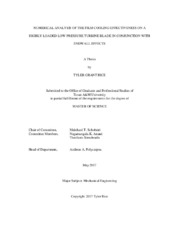| dc.description.abstract | This thesis is a numerical investigation of the flow development of film coolant injected from a turbine blade with considerations to the effects of the passage vortex. By studying the film cooling effectiveness of a low pressure turbine blade subjected to film cooling parameters such as the compound angle injection, Density Ratio, and Blowing Ratio are varied to understand the impact that these parameters have on the passage vortex and film cooling effectiveness in the near endwall region where the passage vortex effects are most prominent. Film Cooling is important in this region as the passage vortex region of a blade is susceptible to high heat transfer and thermal stresses, which can greatly reduce the life cycle of a turbine blade.
For this study, a special blade was designed that has a total of 605 holes distributed along 13 different rows on the blade surfaces. 6 rows cover the suction side, 6 other rows cover the pressure side and one last row feeds the leading edge. There are six coolant cavities inside the blade. Each cavity is connected to one row on either sides of the blade, except for the closest cavity to leading edge since it is connected to the leading edge row as well. By using ANSYS CFX, a RANS based solver as a computational platform, the study first compared to an experimental benchmark to understand the deficiencies of the numerical simulation, in that the velocity fluctuations were overpredicted in the boundary layer, thus effecting the prediction of mass, momentum, and energy transport. Secondly, in varying the different parameters the interaction of the film cooling vortices and passage vortex is studied. The development of the film cooling iii vortices with varying parameters and the effects due to the passage vortex in the near endwall region is identified for each parameter. Ultimately, the passage vortex, displaced coolant away from the endwall at the same rate as the vorticity magnitude and size of the passage vortex is much larger than that produced from film cooling. | en |


